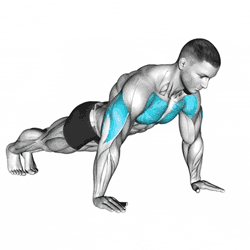Push-Ups: A Guide for Beginners and Experts
Instructions
-
Start Position:
- Place your hands slightly wider than shoulder-width apart, with fingers spread for better grip.
- Keep your feet together or slightly apart for balance.
- Your body should form a straight line from head to heels (plank position).
- Engage your core, squeezing your glutes to avoid sagging in your lower back.
- Your neck should be neutral, with your gaze directed slightly in front of you (not up or down).
-
Lowering Phase (Descent):
- Inhale as you begin to lower your chest to the floor.
- Bend your elbows at about a 45-degree angle to your torso (not flared out too wide).
- Keep your body in a straight line throughout, avoiding arching your back or letting your hips sag.
- Lower your body until your chest is just a few inches off the ground, or until your elbows form a 90-degree angle.
-
Pushing Phase (Ascent):
- Push through your palms, focusing on pressing the ground away to extend your elbows and raise your body.
- Exhale as you push yourself back up.
- Keep your core engaged and your body straight as you return to the starting position.
- Avoid letting your lower back sag or your hips rise early.
-
Repeat:
- Perform for the desired number of reps, maintaining good form throughout.
- Rest briefly if needed, but aim to build endurance as you practice.
Tips
-
Core Engagement:
- A strong core is crucial to prevent your back from sagging. Think of pulling your belly button in towards your spine.
- Engage your glutes to keep your hips aligned with your shoulders and ankles.
-
Proper Hand Placement:
- Hands should be slightly wider than shoulder-width but not excessively so. This allows for a more natural range of motion.
- Keep your fingers spread out for better grip and control.
-
Elbow Positioning:
- Avoid flaring your elbows out too far; they should angle about 45 degrees to your body.
- This helps to recruit the correct muscles and reduce strain on your shoulders.
-
Breathing:
- Inhale as you lower your body and exhale as you push back up. Proper breathing ensures you have enough energy to perform the movement efficiently.
-
Scaling:
- If regular push-ups are too difficult, you can scale by performing push-ups on your knees or by elevating your hands (e.g., against a box or bench).
- For more advanced variations, you can add explosive movements (e.g., clapping push-ups), or increase the volume and intensity with time-based sets.








